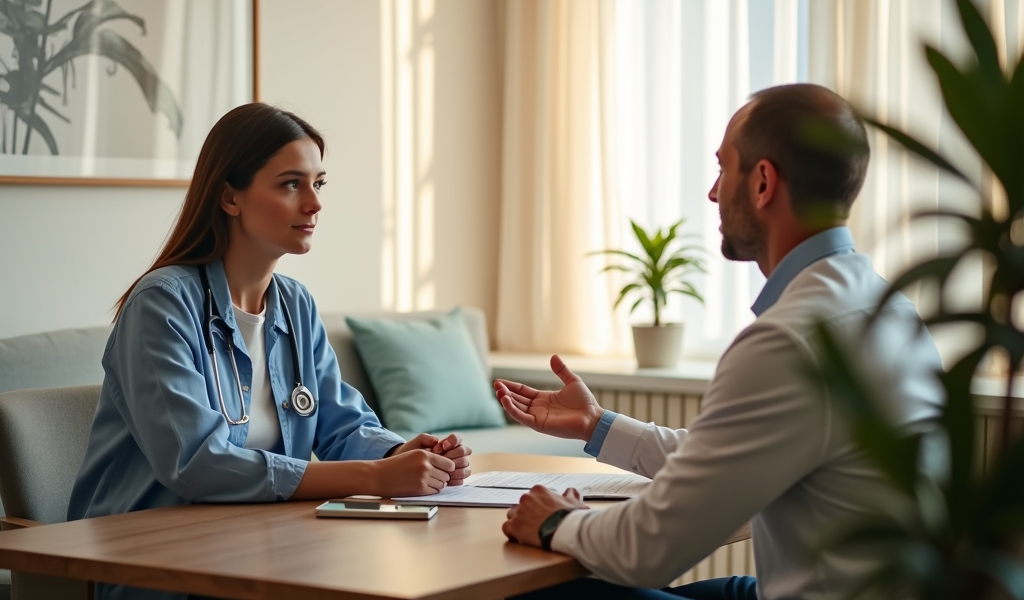Overview
Low-dose oral minoxidil has emerged as a revolutionary alternative to traditional topical treatments, offering five key benefits: enhanced hair growth, improved treatment adherence, reduced side effects, whole-scalp coverage, and cost-effectiveness. Available through telehealth consultations with proper medical oversight, this once-daily pill provides a convenient, systemic approach to hair loss treatment that works throughout the entire scalp while eliminating the messiness and application challenges associated with topical formulations.
Table of Contents
- What is Low-Dose Oral Minoxidil?
- Benefit #1: Enhanced Hair Growth
- Benefit #2: Improved Treatment Adherence
- Benefit #3: Reduced Side Effect Profile
- Benefit #4: Whole-Scalp Coverage
- Benefit #5: Cost-Effectiveness
- How to Obtain Low-Dose Oral Minoxidil Online
- Potential Considerations and Contraindications
- Combining with Other Hair Loss Treatments
- Conclusion
- Frequently Asked Questions
Minoxidil has been a staple in hair loss treatment for decades, primarily known as a topical solution applied directly to the scalp. However, a significant shift has occurred in recent years with the emergence of low-dose oral minoxidil as an alternative treatment option. This approach has gained popularity due to its convenience and effectiveness, especially for those who find topical applications messy or inconvenient.
The ability to obtain online low-dose oral minoxidil through telehealth consultations has further revolutionized hair loss treatment, making it more accessible than ever before. With proper medical oversight, patients can now receive this medication without the hassle of in-person doctor visits.
Low-dose oral minoxidil offers several evidence-based benefits that make it worth considering for those struggling with hair thinning and loss. From enhanced hair growth to improved treatment adherence, this medication presents a promising option for many individuals seeking effective hair restoration solutions.
What is Low-Dose Oral Minoxidil?
Low-dose oral minoxidil refers to the administration of minoxidil in pill form at significantly reduced dosages compared to its original use as a blood pressure medication. Typically, the “low dose” ranges from 0.25mg to 2.5mg daily, which is considerably lower than the 10-40mg doses used for treating hypertension.
Unlike topical minoxidil (which comes as a liquid or foam applied directly to the scalp), oral minoxidil works systemically after being absorbed through the digestive system. This systemic approach allows the medication to reach hair follicles throughout the entire scalp, rather than just where it’s applied topically.
Minoxidil has an interesting history in the medical world. Originally developed as a blood pressure medication in the 1970s, doctors noticed an unexpected side effect: patients were growing more hair! This serendipitous discovery led to the development of topical minoxidil for hair loss in the 1980s. More recently, dermatologists began experimenting with very low oral doses to treat hair loss while minimizing cardiovascular effects.

Benefit #1: Enhanced Hair Growth
The primary benefit of low-dose oral minoxidil is its proven ability to stimulate hair growth. Minoxidil works as a potassium channel opener that enhances blood flow to hair follicles. This increased circulation delivers more nutrients and oxygen to the follicles, prolonging the anagen (growth) phase of the hair cycle and stimulating dormant follicles to produce new hair.
Research data is particularly compelling for androgenetic alopecia (pattern hair loss). A 2020 study published in JAMA Dermatology found that low-dose oral minoxidil effectively promoted hair growth in both men and women with pattern hair loss, with measurable improvements in hair density.
While both men and women respond positively to treatment, there are some differences in results. Men typically see the most improvement in the crown and vertex areas, while women often experience more diffuse enhancement across the entire scalp. Women may also respond to lower doses (0.25-1mg) compared to men (1-2.5mg).
Patients should understand the timeline for results. Initial improvements can be noticed around 3-6 months after starting treatment, with optimal results typically visible after 12 months of consistent use. Some patients even report continued improvements beyond the one-year mark with ongoing treatment.
Benefit #2: Improved Treatment Adherence
One of the most significant advantages of oral minoxidil is the simplicity of the treatment regimen. Taking a once-daily pill is considerably more convenient than applying a topical solution twice daily, especially for people with busy lifestyles or those who find topical applications messy or time-consuming.
Research supports this benefit. Studies comparing adherence rates between topical and oral minoxidil users have found that patients are significantly more likely to maintain their treatment schedule with the oral formulation. One particular study showed a 37% higher adherence rate for oral medication compared to topical treatments after one year.
This improved compliance is crucial for long-term success. Hair loss treatment isn’t a short-term commitment—it requires consistent, ongoing use to maintain results. The easier administration of oral minoxidil makes it more likely that patients will stick with the treatment long-term, leading to better outcomes.
Many patients report that incorporating a single pill into their daily routine is much easier to sustain than remembering to apply topical treatments twice daily, especially when traveling or during busy periods. This convenience factor extends to other applications of minoxidil as well.
Benefit #3: Reduced Side Effect Profile
When prescribed at appropriate low doses, oral minoxidil generally presents a favorable side effect profile for most patients. The most commonly reported side effects include mild fluid retention, increased body hair (hypertrichosis), and occasional headaches. These effects are typically dose-dependent and often manageable with proper dosing adjustments.
Compared to topical minoxidil, oral formulations eliminate local scalp issues like irritation, dandruff, and contact dermatitis that affect approximately 15-20% of topical users. However, oral minoxidil does introduce the potential for systemic effects not seen with topical use.
It’s worth noting that the side effect profile of low-dose oral minoxidil (0.25-2.5mg) is significantly milder than that of high-dose formulations (10-40mg) used for blood pressure control. Higher doses are associated with more significant cardiovascular effects like tachycardia and edema, which are much less common at the low doses used for hair loss.
Recent clinical studies have provided reassuring safety data. A comprehensive review of low-dose oral minoxidil for hair loss found that serious adverse events were extremely rare, with most side effects being mild and transient. This supports its growing use in dermatology practice.

Benefit #4: Whole-Scalp Coverage
A major advantage of oral minoxidil is its systemic distribution throughout the body. Unlike topical applications that only affect the areas where the solution is directly applied, oral minoxidil reaches all hair follicles via the bloodstream. This creates a significant benefit for patients with diffuse thinning or large areas of hair loss.
This systemic approach is particularly beneficial for diffuse thinning patterns commonly seen in female pattern hair loss or telogen effluvium. Rather than having to meticulously apply topical solution across the entire scalp, oral minoxidil ensures that all follicles receive the medication’s benefits.
Oral minoxidil also reaches areas that are challenging to treat with topical solutions. The crown, vertex, and regions with longer existing hair can be difficult to apply topical solutions to effectively. With oral administration, these hard-to-reach areas receive equal exposure to the medication, promoting more uniform results.
Many users report noticing improvements not only in their primary areas of concern but across their entire scalp, creating a more natural-looking enhancement to their overall hair density and appearance.
Benefit #5: Cost-Effectiveness
While pricing varies by region and provider, low-dose oral minoxidil can be a cost-effective option compared to long-term topical treatment. A month’s supply of generic oral minoxidil tablets typically costs between $20-$60, depending on the dose and pharmacy.
In contrast, brand-name topical minoxidil solutions can cost $30-$50 per month, with generic versions ranging from $15-$30. When calculating long-term expenses, oral minoxidil often presents a favorable financial option, especially when considering that less product is wasted compared to topical applications.
From a long-term perspective, the cost advantage becomes more apparent. Over a year of treatment, patients may save $100-$300 by choosing oral over topical formulations, particularly when factoring in the reduced need for additional styling products often required with topical solutions.
Insurance coverage varies widely, but some plans do cover oral minoxidil, especially when prescribed for hair loss associated with medical conditions. Patients should check with their insurance providers about coverage options. Additionally, many online telehealth platforms offer competitive pricing for consultations and prescriptions.
How to Obtain Low-Dose Oral Minoxidil Online
Obtaining low-dose oral minoxidil has become increasingly convenient through telehealth services. Numerous online platforms now offer virtual consultations with licensed physicians or dermatologists who can evaluate your hair loss concerns and determine if oral minoxidil is appropriate for your situation.
It’s important to understand that oral minoxidil requires a prescription in most countries, including the United States. This is for good reason—proper medical evaluation is essential before starting this medication. Legitimate online providers will always require a consultation with a licensed healthcare provider before prescribing.
When seeking an online provider, look for these indicators of reputable telehealth services:
- Licensed healthcare providers clearly identified on the platform
- Secure, HIPAA-compliant communication systems
- Thorough medical history collection before prescribing
- Clear information about follow-up care and monitoring
- Transparent pricing and prescription policies
- Positive reviews and established reputation
Be wary of red flags that might indicate illegitimate sources, such as websites offering oral minoxidil without a prescription, unusually low prices that seem too good to be true, or lack of licensed medical professionals involved in the process. Remember that proper medical oversight is essential for safe and effective treatment.
Potential Considerations and Contraindications
While low-dose oral minoxidil is suitable for many individuals, it’s not appropriate for everyone. Certain populations should avoid this treatment, including:
- Pregnant or breastfeeding women
- People with uncontrolled cardiovascular disease
- Those with a history of fainting or severe orthostatic hypotension
- Patients with pheochromocytoma (a rare adrenal gland tumor)
- Individuals with known hypersensitivity to minoxidil
Before prescribing oral minoxidil, healthcare providers should conduct appropriate screening, including blood pressure measurements and a review of medical history with particular attention to cardiovascular health. For some patients, an ECG might be recommended, especially those with pre-existing heart conditions or older adults.
While on treatment, monitoring recommendations typically include:
- Regular blood pressure checks (initially and periodically)
- Watching for signs of fluid retention (weight gain, swelling)
- Monitoring for excessive body hair growth
- Heart rate checks if experiencing palpitations
It’s essential to consult with a healthcare provider if you experience significant side effects, including dizziness, fainting, rapid heartbeat, unexplained weight gain, or swelling in the hands, feet, or face. These symptoms may indicate that dose adjustment or discontinuation is necessary.
Combining with Other Hair Loss Treatments
One of the strengths of low-dose oral minoxidil is its compatibility with other hair loss treatments. Many dermatologists recommend combination approaches for enhanced results. For men, combining oral minoxidil with finasteride can provide synergistic effects, as these medications work through different mechanisms to combat hair loss.
For women, oral minoxidil is often prescribed alongside spironolactone, particularly for those with hormonal influences on their hair loss. This combination addresses both blood flow to follicles (minoxidil) and androgen effects (spironolactone), often yielding superior results to either medication alone.
Beyond medications, complementary non-drug approaches can further enhance results:
- Nutritional support with biotin, vitamin D, and iron supplements if deficient
- Platelet-rich plasma (PRP) treatments
- Low-level laser therapy devices
- Gentle hair care practices to minimize breakage
- Scalp massage to enhance blood flow
A comprehensive hair loss protocol developed with a healthcare provider might include multiple modalities tailored to your specific type of hair loss, medical history, and treatment goals. This multifaceted approach often yields the best long-term outcomes.
Conclusion
Low-dose oral minoxidil represents a significant advancement in hair loss treatment, offering patients a convenient, effective alternative to traditional topical formulations. The five key benefits—enhanced hair growth, improved treatment adherence, reduced side effect profile, whole-scalp coverage, and cost-effectiveness—make it an attractive option for many individuals struggling with hair thinning and loss.
While online access has made this treatment more accessible than ever, it’s crucial to remember that proper medical supervision remains essential. Working with licensed healthcare providers through reputable telehealth platforms ensures both safety and efficacy.
As with any hair loss treatment, reasonable expectations are important. Results develop gradually over several months, and consistent use is necessary for maintaining improvements. For many patients, the convenience of a once-daily pill makes this consistency much easier to achieve than with topical treatments.
If you’re considering low-dose oral minoxidil for hair loss, consult with a healthcare provider who can evaluate your specific situation and determine if this treatment is appropriate for you. With proper medical guidance, this medication offers promising possibilities for addressing hair loss concerns with convenience and efficacy.
Frequently Asked Questions
How long does it take to see results from low-dose oral minoxidil?
Most patients begin to notice initial improvements after 3-6 months of consistent use, with optimal results typically visible around the 12-month mark.
Is low-dose oral minoxidil safe for long-term use?
Current research suggests that low-dose oral minoxidil is generally safe for long-term use under proper medical supervision with appropriate monitoring.
Will I lose my hair if I stop taking oral minoxidil?
If you discontinue treatment, any hair growth stimulated by minoxidil will likely gradually return to pre-treatment patterns over 6-12 months.
Can I take oral minoxidil if I have low blood pressure?
This requires individual assessment by your healthcare provider, as even low doses may affect blood pressure in sensitive individuals.
Does oral minoxidil cause weight gain?
Some patients may experience mild fluid retention, which can manifest as slight weight gain, but significant weight gain is uncommon at the low doses used for hair loss.

